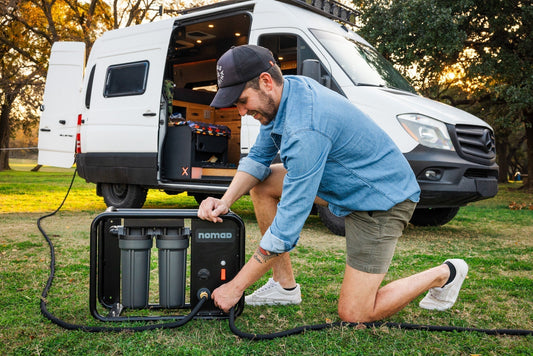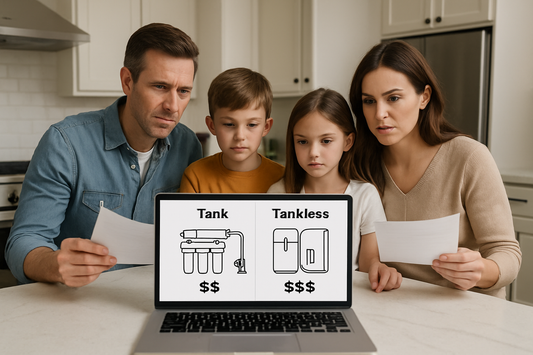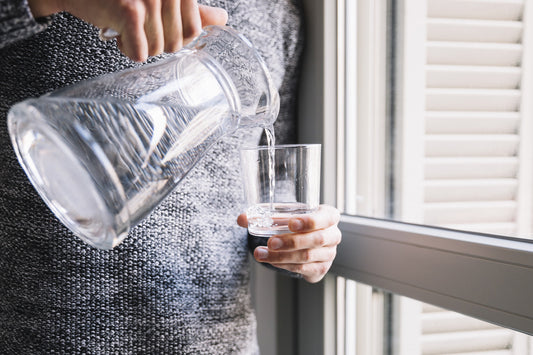How to Test Water Hardness at Home:
Your Complete Testing and Solutions Guide
Hard water affects over 85% of American homes, yet many homeowners remain unaware of its presence until costly damage occurs. Learning how to test water hardness at home empowers you to protect your appliances, improve your daily comfort, and make informed decisions about water treatment solutions.
Whether you're noticing soap scum buildup, experiencing dry skin after showers, or seeing white spots on dishes, these signs often point to hard water issues. This comprehensive guide will walk you through proven hard water test methods and help you understand when professional solutions become necessary.
Understanding Hard Water:
What Every Homeowner Should Know
Hard water contains elevated levels of dissolved minerals, primarily calcium and magnesium. These minerals accumulate as groundwater passes through limestone, chalk, and gypsum deposits. While not harmful to drink, hard water creates numerous household challenges that impact both comfort and finances.
The hardness level is typically measured in grains per gallon (gpg) or parts per million (ppm). Water with 7-10 gpg is considered moderately hard, while levels above 10 gpg indicate very hard water that requires immediate attention.
Common Signs Your Water Needs Testing
Before diving into testing methods, recognize these telltale signs of hard water:
- Soap doesn't lather well in sinks or showers
- White, chalky buildup on faucets and showerheads
- Spots on glassware and dishes after washing
- Dry, itchy skin and brittle hair
- Reduced efficiency in water-using appliances
- Higher energy bills due to scale buildup in water heaters

Image by AdamRadosavljevic
DIY Water Hardness Testing Methods: Start Simple
The Classic Soap Test: Your First Indicator
The soap test remains one of the most accessible ways to gauge water hardness using items you likely have at home. This method has helped homeowners identify hard water for generations.
Materials needed:
- Clear plastic bottle with cap
- Pure liquid soap (avoid detergents with additives)
- Tap water sample
Step-by-step process:
- Fill the bottle one-third with tap water
- Add 10 drops of pure liquid soap
- Cap tightly and shake vigorously for 10 seconds
- Observe the results immediately
Interpreting your results:
- Abundant, fluffy suds with clear water below indicate soft water
- Few suds with cloudy, milky water suggest moderate to hard water
- Minimal suds with very cloudy water confirm very hard water
While this test provides a general indication, it won't give you precise measurements needed for selecting appropriate treatment systems.
Water Hardness Testing Kits: Accurate Home Analysis
For homeowners seeking precise measurements, a water hardness testing kit offers laboratory-level accuracy at an affordable price. These kits typically include test strips or liquid reagents that react with minerals in your water.
Using test strips effectively:
- Collect a fresh water sample in a clean container
- Dip the test strip completely for 2-3 seconds
- Remove and shake off excess water immediately
- Wait exactly 60 seconds for color development
- Compare colors to the provided chart
Professional tip: Test water from multiple faucets throughout your home. Kitchen faucets often show different readings than bathroom taps due to varying pipe materials and ages.
Digital TDS Meters: Technology Meets Convenience
Total Dissolved Solids (TDS) meters provide instant digital readings of mineral content in your water. While not measuring hardness directly, TDS levels correlate strongly with water hardness and offer valuable insights.
Using a TDS meter:
- Calibrate according to manufacturer instructions
- Insert into room-temperature water sample
- Record the reading in ppm
- Generally, readings above 300 ppm suggest hard water conditions
When Professional Water Testing Becomes Essential
While home testing methods provide valuable insights, professional water analysis offers comprehensive results that guide long-term solutions. Consider professional testing when:
- Home tests show inconsistent results
- You're planning major appliance purchases
- Family members experience persistent skin or hair issues
- You're considering whole-house water treatment systems
Professional testing reveals not only hardness levels but also pH, iron content, chlorine levels, and potential contaminants that affect water quality and treatment effectiveness.
Understanding Your Test Results:
What the Numbers Mean
Hardness Classification:
- 0-3 gpg (0-60 ppm): Soft water
- 4-7 gpg (61-120 ppm): Moderately hard
- 8-12 gpg (121-180 ppm): Hard water
- 13+ gpg (181+ ppm): Very hard water
Each classification level impacts your household differently. Moderately hard water might only affect soap performance, while very hard water can significantly reduce appliance lifespan and increase maintenance costs.

Image by atlascompany
Solutions for Hard Water: From Simple Fixes to Complete Systems
If Your Tests Reveal Hard Water...
Don't panic – effective solutions exist for every hardness level and budget. The key lies in matching the right treatment system to your specific needs and water conditions.
For moderate hardness (4-7 gpg): Point-of-use solutions often suffice. Under-sink reverse osmosis systems like those from Waterdrop provide excellent drinking and cooking water while addressing localized hard water issues. These systems excel at removing minerals that cause hardness while improving taste and clarity.
For hard to very hard water (8+ gpg): Whole-house solutions become necessary to protect your entire plumbing system and all water-using appliances. Crystal Quest whole-house water filtration systems offer comprehensive protection, removing hardness-causing minerals before they enter your home's plumbing network.
Choosing the Right Water Treatment System
The decision between point-of-use and whole-house systems depends on several factors:
Consider whole-house systems when:
- Multiple family members experience hard water effects
- Appliances show signs of scale buildup
- Hardness levels exceed 10 gpg
- You want comprehensive home protection
Point-of-use systems work well for:
- Targeting specific water uses (drinking, cooking)
- Budget-conscious homeowners
- Renters unable to install whole-house systems
- Supplementing existing treatment systems
The Long-Term Benefits of Addressing Hard Water
Investing in proper water treatment pays dividends in multiple ways:
Financial benefits:
- Extended appliance lifespan (water heaters, dishwashers, washing machines)
- Reduced energy costs from improved efficiency
- Lower soap and detergent usage
- Decreased plumbing maintenance needs
Quality of life improvements:
- Softer, more manageable hair
- Smoother, less irritated skin
- Cleaner dishes and glassware
- Better-tasting beverages and food
Maintaining Your Water Quality:
Ongoing Testing and Care
Water hardness can change over time due to seasonal variations, infrastructure changes, or new water sources. Establish a testing routine to ensure your water treatment systems continue performing optimally.
Recommended testing schedule:
- Monthly: Quick soap test or TDS meter check
- Quarterly: Test strip analysis
- Annually: Professional comprehensive testing
Regular testing helps you identify when treatment systems need maintenance or replacement, ensuring consistent water quality protection.

Image by freepik
Take Action: Your Path to Better Water Quality
Understanding how to test water hardness at home marks the first step toward improving your family's water quality. Whether you choose simple DIY methods or invest in professional analysis, the knowledge gained empowers you to make informed decisions about water treatment.
Start with a basic soap test or purchase an inexpensive testing kit to establish your baseline hardness levels. If results indicate moderate to severe hardness, explore treatment options that match your specific needs and budget.
Remember, addressing hard water isn't just about immediate comfort – it's an investment in your home's infrastructure, your family's well-being, and your long-term financial health. Every day you delay treatment, hard water continues damaging your appliances and affecting your daily life.





